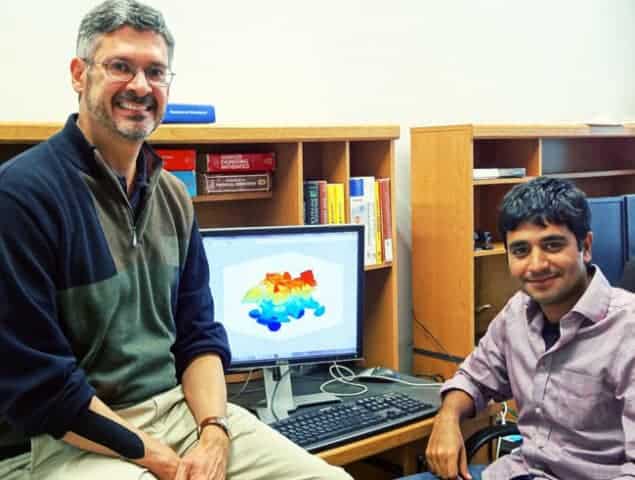
Changes in the mechanical properties of living cells may be responsible for the growth of cancerous tumours, according to computer simulations carried out by scientists in the US. Their work suggests that a softening of cells can change the rate at which cells divide and also make cancer cells survive for longer. Taken together, these two factors could lead to the rapid growth of malignant tumours.
Scientists have long known that most cancers occur when genetic or environmental factors cause changes in how living cells behave. In many cancers these changes seem to occur in the mechanical properties of cells. In particular, cancer cells tend to be softer than healthy cells, with some researchers believing that this greater flexibility can lead to rapid tumour growth.
What Roger Bonnecaze and Parag Katira of the University of Texas at Austin and Muhammad Zaman of Boston University have done is to create a 3D computer model that quantifies the connection between cell softness and tumour growth. The researchers model individual cells as shells of viscoelastic material with liquid cores. In isolation, each cell would simply be a sphere, but the cells can also pack together to form a tissue-like material.
Live, die or divide
The researchers modelled the change in mechanical energy involved in creating such a 3D conglomerate in terms the elastic energy of the shell; the energy released when neighbouring cells stick to one another; and the work done by the osmotic pressure of the cell as its volume changes. These parameters were derived from experimental data for both healthy and cancerous cells.
Bonnecaze and his team ran the simulation until the 3D structure of healthy cells reached its minimum energy configuration, which they used as the initial state for their investigation. The result is a mass of cells that stick to one another at flat interfaces as each cell adopts the shape of a “Voronoi polyhedron”. Such Voronoi polyhedra are objects that can fill 3D space to create a structure that is similar to a tissue of close-packed living cells.
The simulation then allows individual cells to do one of three things: live, die or divide. The probabilities of these events occurring are given by a set of rules that mimic real-life processes – for example that a cell is more likely to die if it is compressed and its surface becomes smaller, but more likely to divide if it spreads out and its surface gets bigger.
Multiplying mutants
When parameters for healthy cells were used, the team found that the simulation reaches an equilibrium in which dead cells are replaced by dividing cells and the overall structure of the tissue remains constant. The team then introduced a small group of mutant cells to the tissue to see if they could mimic tumour growth. These mutants have shells with an elastic modulus that is half that of the healthy cells – thereby making them softer.
When the group consisted of fewer than eight mutants, there was no change in the behaviour of the mutants compared with the healthy cells. However, when eight or more mutants were used, the team saw a significant increase in the multiplication rate of the mutant cells – and the more initial mutants, the greater the rate. This increase in multiplication of the mutants is interpreted as the onset of tumour growth. Indeed, the team says that the simulated growths displayed clinically observed characteristics of malignant tumours.
The team believes that mutants in small groups are surrounded by stiff neighbours and cannot spread out to increase their surface area, which means that they will not divide rapidly. However, above the threshold of about eight cells, some mutant cells are able to push against their soft mutant neighbours and start dividing in earnest.
The team also looked at how the stickiness of the mutant cells affects tumour growth. The researchers found that both changing the strength at which mutant cells stick to each other and the strength at which mutant cells stick to healthy cells affects tumour growth. Interestingly, however, they found that the tumours are most spread out when the stickiness is not changed.
A new approach
“To date, cancer research has focused on biochemical factors,” says Katira. “Instead of trying to solve numerous interdependent biochemical carcinogenic factors, we can now focus on a small number of mechanical factors. It’s a new approach.”
Bonnecaze told physicsworld.com that the team is now looking at creating an experimental realization of the model that would look at the behaviour of cells within a material. Beyond boosting our understanding of cancer, he believes that the simulations could also help scientists understand how wounds heal and could even point the way to organ regeneration and organ growing.
The simulations are described in Physical Review Letters.



